 |

|
 |
Museum Home  Education Education
 Planning a School Visit Planning a School Visit
 Visit Activities Visit Activities
 Getty Center Pre-Visit Activities Getty Center Pre-Visit Activities
|
 |
 |
 |



These activities are designed to prepare your students for a School Visit to the Getty Center. Please complete the first two activities before your School Visit. If you will have a Guided Lesson, you will also complete the appropriate pre-visit activity for your lesson.
|
 |

|
 |
 |
Activities 1–10 of 11 |
 |
 |
 |
 |
 |

  |
 |
Protecting Art for Future Generations
Grades/Level: Lower Elementary (K–2), Upper Elementary (3–5), Middle School (6–8), High School (9–12)
Subjects: Visual Arts
Activity Overview: It's only natural for visitors to want to touch the beautiful works of art they see in the Museum. Usually they don't realize the cumulative damage that results when many people touch an object, even very lightly. Before your visit, this simple activity will help your students understand why they should avoid touching art in the Museum.
|
 |
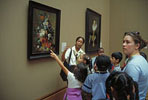 |
 |
Video Introduction to the Getty Center
Grades/Level: Lower Elementary (K–2), Upper Elementary (3–5), Middle School (6–8), High School (9–12)
Subjects: Visual Arts
Activity Overview: Students who will have a Guided Lesson at the Getty Center watch a video that introduces them to the Museum's collections and to the interactive teaching style practiced by our educators. As demonstrated in the video, students will be encouraged to share their personal reactions to works of art through discussion or writing activities. Self-Guiding teachers may wish to view the video(s) online as preparation for their visit to the Getty Center.
|
 |
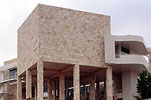 |
 |
Natural Wonders
Grades/Level: Lower Elementary (K–2)
Subjects: Visual Arts
Activity Overview: This activity prepares students for the Guided Lesson at the Getty Center, Nature in Art. Students consider how an artist interprets and represents nature. They look at a poster of Breughel's painting of Noah's Ark, with many natural elements, and share their personal ideas about what they see.
|
 |
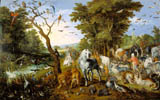 |
 |
Reading Stories in Art
Grades/Level: Lower Elementary (K–2), Upper Elementary (3–5), Middle School (6–8), High School (9–12)
Subjects: Visual Arts
Activity Overview: This activity prepares students for the Guided Lesson at the Getty Center, Artists as Storytellers. Students learn how artists tell stories using visual images by identifying and comparing elements of narrative (setting, characters, and plot) in a painting and a Greek vase. They will discuss their ideas together.
|
 |
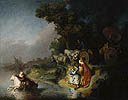 |
 |
Looking at Body Language
Grades/Level: Lower Elementary (K–2), Upper Elementary (3–5), Middle School (6–8), High School (9–12)
Subjects: Visual Arts
Activity Overview: This activity prepares students for the Guided Lesson in the Museum at the Getty Center, Body Language. Students will look at Dorothea Lange's photograph of a migrant mother and consider how artists express emotions, ideas and physical conditions through gesture, pose, clothing and expression.
|
 |
 |
 |
Introducing Mythology
Grades/Level: Middle School (6–8), High School (9–12)
Subjects: Visual Arts
Activity Overview: This activity prepares students for the Guided Lesson at the Getty Center, Mythology in European Art. Students look closely at a reproduction of a Rembrandt painting, which represents the mythological story of the abduction of Europa. They will consider how the artist interpreted and represented the setting, characters, and action in his own way.
|
 |
 |
 |
Learning to Look
Grades/Level: Middle School (6–8), High School (9–12)
Subjects: Visual Arts, History—Social Science
Activity Overview: This activity prepares students for the Guided Lesson at the Getty Center, Connecting History and Art. Students will look at Jacques-Louis David's Telemachus and Eucharis and Dorothea Lange's photograph of a migrant mother and consider how artists communicate ideas across time. This activity will get your students thinking, wondering, and asking questions about what they see so that they can understand the message the artist is trying to communicate.
|
 |
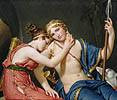 |
 |
Writing to See
Grades/Level: Middle School (6–8), High School (9–12)
Subjects: Visual Arts, English—Language Arts
Activity Overview: This activity prepares students for the Guided Lesson at the Getty Center, Exploring Art Through Writing. In this lesson, students will use writing activities as a way to engage with works of art. Two writing exercises focused on a work of art—descrptive writing and creative writing—are designed to help students slow down, look carefully, and think about what they see.
|
 |
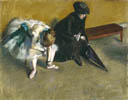 |
 |
Making Connections
Grades/Level: Middle School (6–8), High School (9–12)
Subjects: Visual Arts, English—Language Arts
Activity Overview: Build student awareness of the relationship between words and images. Students will identify the main ideas in a passage from literature, and in a painting, and justify their conclusions using logic and language arts skills.
|
 |
 |
 |
Thirty-Second Look—Getty Center
Grades/Level: Lower Elementary (K–2), Upper Elementary (3–5), Middle School (6–8), High School (9–12)
Subjects: Visual Arts, English—Language Arts
Activity Overview: Students are taught how to see and learn more about works of art from close observation.
|
 |
 |
 |
 |
 |
 |
Activities 1–10 of 11 |
 |
 |
 |
 |
 |

  |
 |
|
 |

 |
 |
 |
 |
|